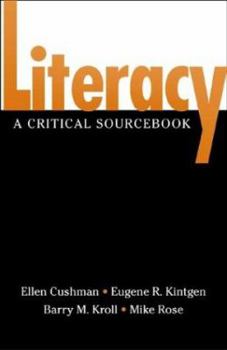Literacy: A Critical Sourcebook
Select Format
Select Condition 
Book Overview
This new collection of both landmark and current essays provides a comprehensive overview of the major themes and questions that shape literacy studies today. Literacy: A Critical Sourcebook is an... This description may be from another edition of this product.
Format:Paperback
Language:English
ISBN:0312250428
ISBN13:9780312250423
Release Date:March 2001
Publisher:Bedford Books
Length:804 Pages
Weight:2.25 lbs.
Dimensions:1.2" x 6.1" x 9.1"
Related Subjects
Creative Writing & Composition Language Arts Literature Reference Writing Writing SkillsCustomer Reviews
3 ratings
LSIMM017 REVIEW
Published by Thriftbooks.com User , 14 years ago
I have read 3 very diverse chapters from this book, all of which are the basis for my review. Chapter 4: From Pencils to Pixels: The Stages of Literacy Technologies, written by Dennis Baron, has been very informative. He argues that computers are just another evolution of tools that affect literacy. Baron describes the history of literary tools like the pencil, typewriter and eventually the computer. He discusses how we should welcome these new ideas for writing tools and we should embrace them in the literary classroom. He gives Plato's surprising resistance of writing as an example of how we as a society have progressed and those actions/tools once thought of as negative or too advanced are now common facets we can't function without. Plato thought that if we wrote our ideas down then we would lose our ability to communicate orally. In summary this was a great look at the connection between past and present technologies that have contributed to today's literacy. Chapter 17: Gender, Advertising and Mass-Circulation Magazines written by Helen Damon-Moore & Carl F. Kaestle, discusses the development and evolution of gender roles and how they correlated with advertising in magazines and the overall development of various magazines like The Ladies Home Journal and the Saturday Evening Post. The authors discuss how magazines changed according to women's roles in the home, including becoming the general purchaser regarding household items, groceries and clothing. Due to the overwhelming audience received by The Ladies Home Journal, the authors tried to describe the effects various editors tried to repeat with men's journals. Overall this essay is a very good break down and history of the development of gender role influenced magazines. The book is basically a combination of essays and ideas concerning various aspects of literacy. It criticizes, analyzes and gives the reader a historical overview of literacy trends and subject areas. Chapter 23: A World Without Print, by Victoria Purcell-Gates, was my favorite of the three chapters I have read. The author discusses the details of a study she conducted with an illiterate mother and her son. The mother dropped out of school in the 7th grade, as did her husband, the child didn't attend kindergarten because the mother couldn't read to comprehend what was required of him regarding his education. She has enrolled in an afterschool literacy program at a local university with her son to educate herself and him (he's in the second grade and can't read or write, including his ABC's). The author explores how children learn literacy, focusing on those that don't have influences at home regarding literacy; the little boy and his mother.
Good Lit Book
Published by Thriftbooks.com User , 14 years ago
I liked the way various authors shared their views on different subjects instead of there being just one constant voice. This helped open up new ideas and new interpretations on what literacy is and how it is addressed in various aspects. The three chapters I concentrated on most throughly were twelve, thirteen, and fourteen. Chapter twelve, though good, did appear to be a little cluttered with so much information compacted into such a short space. What the author, Harvey J. Graff, did write on, however, did keep me interested and I learned a lot from his perspective. He lists how literacy changes through time and how different groups, i.e. poor, african americans, enlistees etc., were treated concerning literacy and how they themselves embraced it. Chapter thirteen, written by Jamie Candelaria Greene, was about how literacy is often portrayed by scholars as being limited in the ways it was brought and expanded in America. Greene argues that many forget the Spanish influence on literacy. However, limiting the chapter to Spanish influence excludes the monumental influence of Native Americans. I feel that Greene's argument seems then almost null and void, because in one case he is saying "what about the spanish," but in the other, by his own actions, is disregarding other prominent influences on literacy. Chapter fourteen, written by David Paul Nord, is a overview of the impact, experiences, and teachings of the American Tract Society in Antebellum America. The author does a good job in having a balanced view of what happened and the various ways the tracts were received. I feel though, that the chapter was redundant, and most of what was said was just an echo of an earlier paragraph.
A must own
Published by Thriftbooks.com User , 14 years ago
This is an essential volume of essays on literacy research that any interested scholar should consult. A great essay by Harvey J. Graff, an essential essay on Service learning, and a very helpful essay on ethnography by Szwed. This book is referenced constantly by literacy scholars. You will not be disappointed with it!





